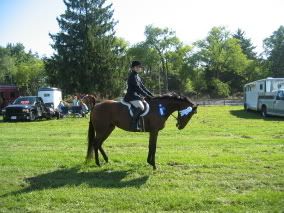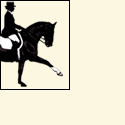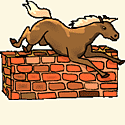The proper leg-yeild
Moderator: EC
9 posts
• Page 1 of 1
The proper leg-yeild
#ed_op#DIV#ed_cl#I've been working with Zippy on her leg yeilding (both across the diagonal and along the wall- facing both toward the wall and then toward the center).#ed_op#/DIV#ed_cl##ed_op#DIV#ed_cl# #ed_op#/DIV#ed_cl##ed_op#DIV#ed_cl#Now, if I have this right, when a horse leg yeilds, they should be moving both the front and back leg over at the same time, correct?#ed_op#/DIV#ed_cl##ed_op#DIV#ed_cl# #ed_op#/DIV#ed_cl##ed_op#DIV#ed_cl#How do you achieve this? #ed_op#/DIV#ed_cl##ed_op#DIV#ed_cl# #ed_op#/DIV#ed_cl##ed_op#DIV#ed_cl#Currently, Zippy moves one at a time (which is ok for now, because I'm working on keeping her straight, while still keeping a close angle to the rail- as in having not just side pass)- but I want to fix it because she is moving into the next step.#ed_op#/DIV#ed_cl##ed_op#DIV#ed_cl# #ed_op#/DIV#ed_cl##ed_op#DIV#ed_cl#Also, any tricks to get a horse leg yeilding at the trot?#ed_op#/DIV#ed_cl##ed_op#DIV#ed_cl# #ed_op#/DIV#ed_cl##ed_op#DIV#ed_cl#Currently, I'm just asking her to do it across the diagonal. She can kind of do it- to the point that she can move diagonally across, however, she isn't properly working under herself and moving straight off the leg (she doesn't quite understand that yes, she CAN do that). How can I help her get it better?#ed_op#/DIV#ed_cl#
*God forbid I go to any heaven where there are no horses*
-

*Giddy Up* - Friends Of EC

- Posts: 8968
- Joined: Mon Jun 30, 2003 10:44 pm
- Location: Canada
#ed_op#DIV#ed_cl#It is best to practice near the end of your workout. This way your horse is warmed up and supple. Leg yield is all about timing. When you teach/learn leg yield it is sometimes best to introduce it nose to the wall. Angle the horse coming out of the short corner at a 45 degree angle. The horse should be looking slightly away from the direction he is going. Start at walk and work at co-ordinating the aids. Keep your outside rein so he doesn't fall out or bulge. Carry a whip in the outside hand and if he is sticking or doesn't listen to the leg aids tap the flanks to keep him active. If you practice a few take him into a forward trot and allow him to stretch and maybe try a few more. #ed_op#/DIV#ed_cl#
-

Patricia - Uber Poster

- Posts: 3620
- Joined: Sun Oct 13, 2002 6:55 pm
- Location: Selkirk, Ontario, Canada
#ed_op#DIV#ed_cl#I introduce leg yield first in walk, then when they are understanding that yes, you can move forward and sideways at the same time I start in trot. I don't do the nose to the wall first (although I'm not saying this is not OK, it's just not how I do it personally), I start by coming to just a foot or so off the wall and leg yield the few steps over to the track. The trick is to keep them really straight into the outside rein and not bending too much through the neck and withers. Once they get that then I start coming further off the wall. Another good trick is to leg yield a couple of steps to the wall and then back off the wall. Leg yield is usually one of the first introductions to lateral work, and some horses will take quite some time to fully grasp the concept. Outside rein and inside leg at the girth, weight in the direction of bend, and don't be afraid to kick her over, but reward profusely for even small victories.#ed_op#/DIV#ed_cl#
- Ruth
- Uber Poster

- Posts: 6543
- Joined: Sun Oct 13, 2002 6:55 pm
Re: The proper leg-yeild
#ed_op#/DIV#ed_cl##ed_op#DIV#ed_cl# #ed_op#/DIV#ed_cl##ed_op#DIV#ed_cl##ed_op#FONT face=Tahoma color=#c080ff size=4#ed_cl#Firstly to answer your question......no, you do not want them crossing both legs over at the same time. If that were correct, the only horses that would be able to leg yeild that way would be pacers. When the horse is trotting, they are moving their legs in diagonal pairs. So if you were leg yeilding to the right, you would want them to cross the front left leg over, while the right hind leg was reaching over towards the right, then it would be the front right leg reaching, while the hind left leg is crossing.#ed_op#/FONT#ed_cl##ed_op#/DIV#ed_cl##ed_op#DIV#ed_cl##ed_op#FONT face=Tahoma color=#c080ff size=4#ed_cl##ed_op#/FONT#ed_cl# #ed_op#/DIV#ed_cl##ed_op#DIV#ed_cl##ed_op#FONT face=Tahoma color=#c080ff size=4#ed_cl#I hope I understood your question properly....#ed_op#/FONT#ed_cl##ed_op#/DIV#ed_cl##ed_op#DIV#ed_cl##ed_op#FONT face=Tahoma color=#c080ff size=4#ed_cl##ed_op#/FONT#ed_cl# #ed_op#/DIV#ed_cl##ed_op#DIV#ed_cl##ed_op#FONT face=Tahoma color=#c080ff size=4#ed_cl#Now, a really good exercise for some young horses that are just learning to leg yeild is to start out going a few loops down the long side. Don't go all the way to X in you loops, just to the 1/4 line. Do about 2 on each long side. Then the next long side that you come to, start out like you're just going to loop again, but this time when you hit the 1/4 line, leg yeild back to the track. The trick is to have them 100% straight BEFORE you ask them to leg yeild back. So you would have to have the forward, straight working trot, and then ask for leg yeild. If you don't have that, just keep going straight until you get that....then ask for leg yeild. If you only get 1 step before they start backing off (not being forward and straight) or you hit the wall, then fine, no worries. Go straight, set them up again, and go the same thing again. All be careful not to "bull-doze" you corners. Be sure you're sitting up completely straight and not leaning while you horse is turning, for the loops, as that will set them off balance, and make the direction changes that much harder for both of you.#ed_op#/FONT#ed_cl##ed_op#/DIV#ed_cl##ed_op#DIV#ed_cl##ed_op#FONT face=Tahoma color=#c080ff size=4#ed_cl##ed_op#/FONT#ed_cl# #ed_op#/DIV#ed_cl##ed_op#DIV#ed_cl##ed_op#FONT face=Tahoma color=#c080ff size=4#ed_cl#Hope this helps!#ed_op#/FONT#ed_cl##ed_op#/DIV#ed_cl#*Giddy Up* wrote:#ed_op#DIV#ed_cl#Now, if I have this right, when a horse leg yeilds, they should be moving both the front and back leg over at the same time, correct?#ed_op#/DIV#ed_cl##ed_op#DIV#ed_cl# #ed_op#/DIV#ed_cl##ed_op#DIV#ed_cl#How do you achieve this?
I'm the proud new owner of a Fez! hahahaha
-

*rickie* - Uber Poster

- Posts: 2763
- Joined: Mon Sep 15, 2003 6:35 pm
- Location: Canada
#ed_op#font size="3"#ed_cl##ed_op#span class="genmed"#ed_cl##ed_op#b#ed_cl#*Giddy Up* wrote:#ed_op#/b#ed_cl##ed_op#/span#ed_cl##ed_op#/font#ed_cl#
#ed_op##ed_cl##ed_op#font size="3"#ed_cl#Now,
if I have this right, when a horse leg yeilds, they should be moving
both the front and back leg over at the same time, correct? "#ed_op#/font#ed_cl##ed_op#/#ed_cl#
#ed_op#div style="font-style: italic;"#ed_cl##ed_op#font size="3"#ed_cl#No, not correct.
Think about it for a sec and you would realize that there is no way a
horse could cross both legs over at the same and stay on its feet!#ed_op#br#ed_cl#
In leg-yielding and other lateral work, it is important that the horse
maintain the normal rhythm of the walk or trot as it moves. #ed_op#br#ed_cl#
#ed_op#br#ed_cl#
#ed_op#/font#ed_cl# #ed_op#/div#ed_cl#
#ed_op##ed_cl##ed_op#font size="3"#ed_cl#Now,
if I have this right, when a horse leg yeilds, they should be moving
both the front and back leg over at the same time, correct? "#ed_op#/font#ed_cl##ed_op#/#ed_cl#
#ed_op#div style="font-style: italic;"#ed_cl##ed_op#font size="3"#ed_cl#No, not correct.
Think about it for a sec and you would realize that there is no way a
horse could cross both legs over at the same and stay on its feet!#ed_op#br#ed_cl#
In leg-yielding and other lateral work, it is important that the horse
maintain the normal rhythm of the walk or trot as it moves. #ed_op#br#ed_cl#
#ed_op#br#ed_cl#
#ed_op#/font#ed_cl# #ed_op#/div#ed_cl#
To ride well is the mark of a gentleman. To ride too well is the sign of a mis-spent youth. Athena the owl in "Outfoxed" by Rita Mae Brown.
-- Distrust any enterprises that require new clothes. EM Forster
-- Distrust any enterprises that require new clothes. EM Forster
-

Judy F - Platinum Member

- Posts: 1783
- Joined: Sun Oct 13, 2002 6:55 pm
- Location: Canada, Ottawa
...
#ed_op#DIV#ed_cl#When I was talking about moving the one side at the same time, I was referring to the walk- yeah, definitely be difficult at the trot- but even thinking about it at the walk, I suppose that put the horse in position to fall over. Not good#ed_op#IMG src="http://forums.equestrianconnection.com/richedit/smileys//smiley17.gif"#ed_cl##ed_op#/DIV#ed_cl##ed_op#DIV#ed_cl# #ed_op#/DIV#ed_cl##ed_op#DIV#ed_cl# #ed_op#/DIV#ed_cl##ed_op#DIV#ed_cl#Thanks for the advice- I will use it!#ed_op#/DIV#ed_cl##ed_op#DIV#ed_cl# #ed_op#/DIV#ed_cl##ed_op#DIV#ed_cl#The point she is at now, is getting her to stay at the 45 degree angle while still keeping her body straight (she tends to bend too much through the body at the 45 degree angle), but sometimes when she is straight she ends up going too close to a 90 degree angle. And I do go both nose to the wall and nose away from the wall.#ed_op#/DIV#ed_cl#
*God forbid I go to any heaven where there are no horses*
-

*Giddy Up* - Friends Of EC

- Posts: 8968
- Joined: Mon Jun 30, 2003 10:44 pm
- Location: Canada
#ed_op#DIV#ed_cl#Well if she is swinging out or bending to much you need more outside rein and outside leg to keep her straight. When learning it is all about co-ordinating the aids. When the outside leg is back I kind of pulsate the outside rein....thinking squeeze NOW....NOW...inconjunction with the outside leg back to block and inside leg at the girth. Ride with a whip. Think rythmn. Like a couple of other said...walk the long side and start about 10' from the wall and leg yield her over. It is only natural for them to gravitate to the wall to search for support. That could be easier as you have forward momentum. #ed_op#/DIV#ed_cl#
-

Patricia - Uber Poster

- Posts: 3620
- Joined: Sun Oct 13, 2002 6:55 pm
- Location: Selkirk, Ontario, Canada
45° is too much angle! It should be more like 35° at the most.#ed_op#br#ed_cl#
In the rule book, article 1.13 describes leg-yielding thus: "3. The
horse is almost straight, except for a slight flexion at the poll away
from the direction in which he moves, so that the rider is just able to
see the eyebrow and nostril on the inside. The inside legs pass
and cross in front of the outside legs."#ed_op#br#ed_cl#
"3.1. Leg-yielding can be performed 'on the diagonal', in which case
the horse should be as nearly as possible parallel to the long sides of
the arena, although the forehand should be slightly in advance of the
quarters. It can also be performed 'along the wall', in which
case the horse should be at an angle of about 35° to the direction in
which he is moving."#ed_op#br#ed_cl#
Be careful not to use too much inside leg or your horse will think you
want him to go THROUGH the wall. My little mare had that problem
and took to rearing (I was asking the impossible) until I deliberately
held my inside leg off the saddle, and used the inside
rein/outside leg to control the angle.#ed_op#br#ed_cl#
In the rule book, article 1.13 describes leg-yielding thus: "3. The
horse is almost straight, except for a slight flexion at the poll away
from the direction in which he moves, so that the rider is just able to
see the eyebrow and nostril on the inside. The inside legs pass
and cross in front of the outside legs."#ed_op#br#ed_cl#
"3.1. Leg-yielding can be performed 'on the diagonal', in which case
the horse should be as nearly as possible parallel to the long sides of
the arena, although the forehand should be slightly in advance of the
quarters. It can also be performed 'along the wall', in which
case the horse should be at an angle of about 35° to the direction in
which he is moving."#ed_op#br#ed_cl#
Be careful not to use too much inside leg or your horse will think you
want him to go THROUGH the wall. My little mare had that problem
and took to rearing (I was asking the impossible) until I deliberately
held my inside leg off the saddle, and used the inside
rein/outside leg to control the angle.#ed_op#br#ed_cl#
To ride well is the mark of a gentleman. To ride too well is the sign of a mis-spent youth. Athena the owl in "Outfoxed" by Rita Mae Brown.
-- Distrust any enterprises that require new clothes. EM Forster
-- Distrust any enterprises that require new clothes. EM Forster
-

Judy F - Platinum Member

- Posts: 1783
- Joined: Sun Oct 13, 2002 6:55 pm
- Location: Canada, Ottawa
#ed_op#DIV#ed_cl#The most common mistake is the lack of forward movement, too much bend, and too much angle. #ed_op#/DIV#ed_cl##ed_op#DIV#ed_cl# #ed_op#/DIV#ed_cl##ed_op#DIV#ed_cl#Judy has it right  #ed_op#/DIV#ed_cl#
#ed_op#/DIV#ed_cl#

-

graciespook - Uber Poster

- Posts: 3621
- Joined: Wed Mar 09, 2005 1:36 pm
- Location: It may be that your sole purpose in life is simply to serve as a warning to others.
9 posts
• Page 1 of 1
Who is online
Users browsing this forum: No registered users and 18 guests